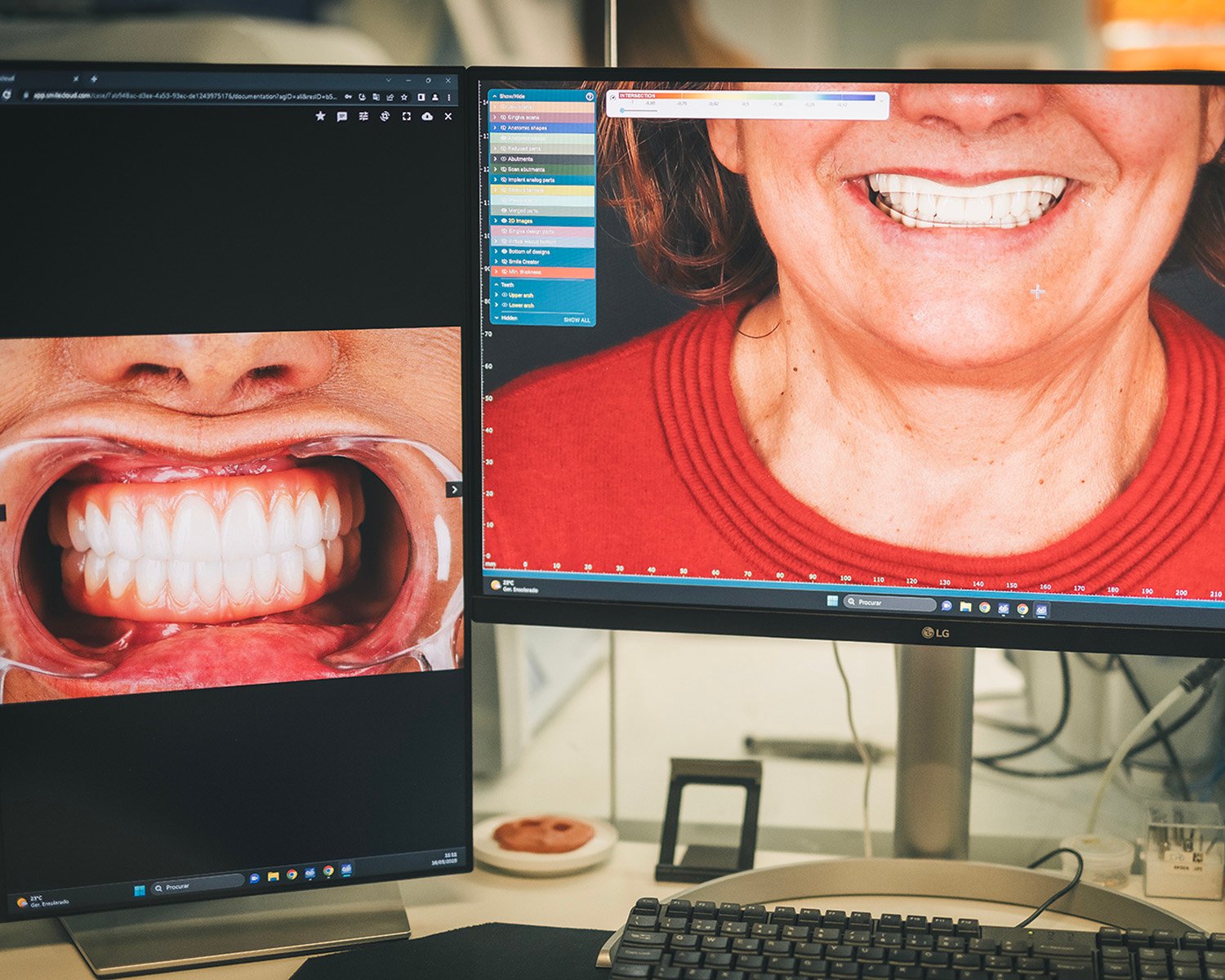Total Fixed Prosthodontics
Recovering the entire dentition
Whether due to a lack of oral hygiene care, an accident or as a consequence of some sort of treatment, many people experience tooth loss. And if one missing tooth makes quite a difference, several or all of them make even more!
Placing dental implants makes it possible to replace missing teeth in a fixed and lasting manner. And while in isolated tooth loss, the solution is single implants with crowns, when there is severe or total tooth loss, a fixed prosthesis is placed over the implants.
Generally, total fixed prosthesis are made up of 12 teeth and screwed to (at least) 4 dental implants, giving the new smile a natural appearance. Apart from the aesthetics, comfort and function also become quite normal for the patients.


The temporary stage
After the surgery for the placement of dental implants, these are scanned to design the new smile. A provisional Total Fixed Prosthesis is placed in approximately one day, with which the patient will remain for about 6 months.
The provisional Total Fixed Prosthesis is screwed to the dental implants and has a very natural appearance, adjusting to the patient’s profile. Furthermore, this is essential so that the patient is not left without teeth during the osseointegration phase – the process in which the biological union between the dental implant and the bone structure occurs – and the healing of the gum tissue.
The new smile
After the osseointegration period, the definitive rehabilitation finally takes place. New photographs are taken, and new impressions are made in order to plan the smile with the desired amendments if they exist, and according to the new position of the soft tissues, now healed.
Then, the new Total Fixed Prosthesis is produced, which will replace the provisional one and will therefore be permanent. Several options are available, and you can learn more about the possibilities at the Hugo Madeira Clinic.
Metal acrylic Total Fixed Prosthesis
This definitive Total Fixed Prosthesis type uses a titanium infrastructure with acrylic teeth. It also has a pink component application in acrylic or composite resin that resembles soft tissues, such as the gums.
In addition, it has the following features:
- Easier to repair and correct;
- Dental arches with fewer dental implants being placed;
- Satisfactory aesthetics;
- Technology that has been studied and with positive results.
Depending on the case’s complexity, the quality of the resins used, and the chewing force, there may be a need to reinforce the acrylic component of this type of prosthesis every 4 or 5 years.
In the metal-acrylic prosthesis, the titanium bar is kept, which is also present in the provisional Fixed Total Prosthesis, and it is possible to replace teeth that show indications of wear.
Total Fixed Prosthesis in Ceramics
Generally, this type of definitive Total Fixed Prosthesis has a zirconium infrastructure with a ceramic covering with more aesthetic properties.
It stands out for its characteristics, such as:
- Superior aesthetic results;
- High durability (3 to 4 times longer than acrylic prosthesis);
- Efficiency in mastication;
- Less retention of odors and tartar.
The Ceramic Total Fixed Prosthesis can remain in excellent condition for 10 years after its placement. However, in cases of complete fracture, it cannot be repaired.
Fixed Total Prosthesis in PMMA and PEEK
This definitive Fixed Total Prosthesis type has a PEEK structure with a PMMA coating. It is manufactured digitally and by using a milling machine (a machine suitable for producing dental prosthesis).
On the one hand, PMMA presents advantages such as:
- Greater mechanical resistance;
- Better marginal adaptation due to the absence of polymerisation contraction;
- Good optical properties due to the high degree of conversion;
- High colour stability;
- Absence of pores and imperfections on the surface of the pre-polymerized blocks, that is the “teeth” of the Total Fixed Prosthesis.
On the other hand, PEEK presents excellent physical and chemical properties, such as:
- Low weight;
- Low resistance to flexure;
- Appropriate elasticity and firmness.
But the main beneficial feature of this material is that its elasticity is lower than the metallic materials and is relatively similar to the human bone, allowing it to reduce the stress on the surrounding bone.
Clinical studies suggest the PEEK structure is an attractive alternative to traditional titanium fixed total prosthesis options due to its superior mechanical properties.
What do I need to prepare for my surgical procedure?
Among your personal belongings and medical records, there are a few things you can’t miss on the day of your surgery to help you feel as comfortable as possible. Below you can find some suggestions.
Personal belongings
- Comfortable, loose-fitting clothing – tight clothing can restrict blood circulation – and a sweater;
- Personal care items;
- If appropriate, glasses, hearing aid, cane, walkers, crutches or other assistive devices you use daily;
- Pillow, favourite blanket, earplugs or eye patch;
- Pen and paper to write down doubts and clarifications;
- Mobile phone charger;
- Music, books, magazines, cards or games to help spend time – at the Hugo Madeira Clinic, patients and visitors can access free Wi-Fi.
Medical records
- Medical tests, examinations, radiology reports and images, implant passport, etc.;
- Medication list and respective dosages – we suggest that you photograph all the medication labels;
- Any documents you have received from the Hugo Madeira Clinic, either by email or post.
